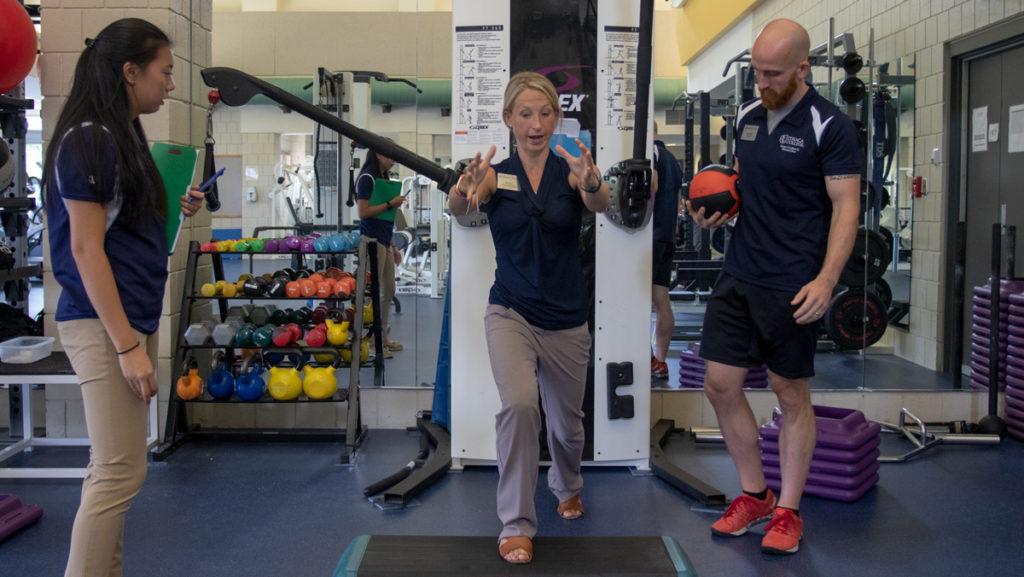Students and faculty of the physical therapy and exercise science departments at Ithaca College will be studying the health and fitness progress of cancer survivors in an eight-week Wellness and Cancer Survivorship Program beginning this fall.
Currently, four local cancer survivors will each be paired with one clinician and two of the 15 students at the Robert R. Colbert Sr. Wellness Clinic in the School of Health Sciences and Human Performance to develop a personalized fitness plan.
Individuals who have been afflicted with nonmetastatic cancer and are within three years of their final chemotherapy, radiation therapy or surgical treatment are eligible to participate in the program and receive a free semester-long membership to the wellness clinic. The goals of the fitness programs are to improve participants’ physical function and states of well-being, counteract the side effects of treatments and strengthen patients’ exercise routines.
Jill Mayer, a clinical assistant professor in the Department of Physical Therapy, previously recognized a lack of local recovery resources for cancer survivors and founded the program. Mayer was inspired to organize the program during Spring 2016 when she collaborated with the Cancer Resource Center of the Finger Lakes, located on West State Street, to create a pilot fitness program for community members.
“It seemed that, although exercise is really beneficial, individuals after a cancer diagnosis weren’t necessarily given the right tools and guidance needed to start an exercise program,” Mayer said.
Frank Micale, clinic director and clinical associate professor in the Department of Exercise and Sport Sciences, will help clients transition into the clinic facilities. Physical activity can reduce the long-term side effects of cancer treatments in cancer survivors, Micale said.
“The fitness program depends on the person, the kind of treatment they had and what kinds of long-term effects there are,” Micale said.
Kayleigh Plumeau, assistant professor and associate director of clinical education in the Department of Physical Therapy, evaluates the participants during the initial assessment to tailor exercise routines to the participants’ capabilities.
“Certain cancer diagnoses require you to prescribe exercises in different ways,” Plumeau said. “There may be some people who need a very slow progression of exercise and less resistance or need functional exercises that help with everyday life.”
At the end of the eight weeks, the research team will conduct post–fitness assessments to reevaluate the participants’ goals, physical fitness and quality of life to determine if any changes have occurred. Mayer anticipates positive improvements in participants’ flexibility, range of motion, endurance and balance.
“These results are really important for us to know what the right exercise prescription for these cancer survivors is based on what kind of diagnosis they have,” Plumeau said.
The program can accept three more participants before fall break this semester, and Mayer hopes to assist more participants throughout the growth of the program between the college and community.
According to the American Cancer Society, the number of cancer survivors in the United States is predicted to grow from 15.5 million as of Jan. 1, 2016 to an estimated 20.3 million by 2026 due to an increasingly aging population, earlier detection and advanced and targeted treatments.
“It’s a huge implication that we’re going to be working with these individuals in the future, and we need to have the tools, resources and skills to be able to provide good care,” Mayer said.
Plumeau said she hopes to learn how to adapt to the pre–existing conditions of the complex cancer survivor population.
“How can I best serve them as a physical therapist, and how can I teach future physical therapists to serve this population better?” Plumeau said.
The Wellness and Cancer Survivorship Program follows an interdisciplinary approach to maximize learning outcomes for the students, faculty and staff, Mayer said.
“We’ve combined exercise science with physical therapy, and with both backgrounds in education, we feel we can provide an optimal program to help cancer survivors succeed in the fitness world,” Mayer said.
Victoria Demiris, a physical therapy graduate student, was nervous to work with a new population at first, despite earning an exercise science degree as an undergraduate at the college. Additional educational experiences in the wellness clinic and treating patients with different diseases have prepared Demiris to construct fitness programs for participants, she said.
“This research program gives me the opportunity to practice my patient skills as well as increase my knowledge on an entirely new patient population,” Demiris said.








